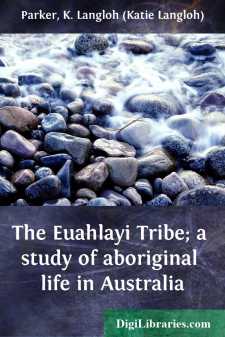Categories
- Antiques & Collectibles 13
- Architecture 36
- Art 48
- Bibles 22
- Biography & Autobiography 813
- Body, Mind & Spirit 142
- Business & Economics 28
- Children's Books 15
- Children's Fiction 12
- Computers 4
- Cooking 94
- Crafts & Hobbies 4
- Drama 346
- Education 46
- Family & Relationships 57
- Fiction 11828
- Games 19
- Gardening 17
- Health & Fitness 34
- History 1377
- House & Home 1
- Humor 147
- Juvenile Fiction 1873
- Juvenile Nonfiction 202
- Language Arts & Disciplines 88
- Law 16
- Literary Collections 686
- Literary Criticism 179
- Mathematics 13
- Medical 41
- Music 40
- Nature 179
- Non-Classifiable 1768
- Performing Arts 7
- Periodicals 1453
- Philosophy 64
- Photography 2
- Poetry 896
- Political Science 203
- Psychology 42
- Reference 154
- Religion 513
- Science 126
- Self-Help 84
- Social Science 81
- Sports & Recreation 34
- Study Aids 3
- Technology & Engineering 59
- Transportation 23
- Travel 463
- True Crime 29
The Euahlayi Tribe; a study of aboriginal life in Australia
Categories:
Description:
Excerpt
INTRODUCTION
No introduction to Mrs. Langloh Parker's book can be more than that superfluous 'bush' which, according to the proverb, good wine does not need. Our knowledge of the life, manners, and customary laws of many Australian tribes has, in recent years, been vastly increased by the admirable works of Mr. Howitt, and of Messrs. Spencer and Gillen. But Mrs. Parker treats of a tribe which, hitherto, has hardly been mentioned by anthropologists, and she has had unexampled opportunities of study. It is hardly possible for a scientific male observer to be intimately familiar with the women and children of a savage tribe. Mrs. Parker, on the other hand, has had, as regards the women and children of the Euahlayi, all the advantages of the squire's wife in a rural neighbourhood, supposing the squire's wife to be an intelligent and sympathetic lady, with a strong taste for the study of folklore and rustic custom. Among the Zulus, we know, it is the elder women who tell the popular tales, so carefully translated and edited by Bishop Colenso. Mrs. Parker has already published two volumes of Euahlayi tales, though I do not know that I have ever seen them cited, except by myself, in anthropological discussion. As they contain many beautiful and romantic touches, and references to the Euahlayi 'All Father,' or paternal 'super man,' Byamee, they may possibly have been regarded as dubious materials, dressed up for the European market. Mrs. Parker's new volume, I hope, will prove that she is a close scientific observer, who must be reckoned with by students. She has not scurried through the region occupied by her tribe, but has had them constantly under her eyes for a number of years.
My own slight share in the book as it stands ought to be mentioned. After reading the original MS., I catechised Mrs. Parker as to her amount of knowledge of the native language; her methods of obtaining information; and the chances that missionary influence had affected the Euahlayi legends and beliefs. I wrote out her answers, and she read and revised what I had written. I also collected many scattered notices of Byamee into the chapter on that being, which Mrs. Parker has read and approved. I introduced a reference to Mr. Howitt's theory of the 'All Father,' and I added some references to other authorities on the Australian tribes. Except for this, and for a very few purely verbal changes in matter of style, Mrs. Parker's original manuscript is untouched by me. It seems necessary to mention these details, as I have, in other works, expressed my own opinions on Australian religion and customary law. [MAKING OF RELIGION, second edition; MYTH, RITUAL, AND RELIGION, second edition.] These opinions I have not, so to speak, edited into the work of Mrs. Parker. The author herself has remarked that, beginning as a disciple of Mr. Herbert Spencer in regard to the religious ideas of the Australians—according to that writer, mere dread of casual 'spirits'—she was obliged to alter her attitude, in consequence of all that she learned at first hand....



